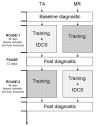Transcranial direct current stimulation (tDCS) combined with blindsight rehabilitation for the treatment of homonymous hemianopia: a report of two-cases
- PMID: 28932016
- PMCID: PMC5599849
- DOI: 10.1589/jpts.29.1700
Transcranial direct current stimulation (tDCS) combined with blindsight rehabilitation for the treatment of homonymous hemianopia: a report of two-cases
Abstract
[Purpose] Homonymous hemianopia is one of the most common symptoms following neurologic damage leading to impairments of functional abilities and activities of daily living. There are two main types of restorative rehabilitation in hemianopia: "border training" which involves exercising vision at the edge of the damaged visual field, and "blindsight training," which is based on exercising the unconscious perceptual functions deep inside the blind hemifield. Only border effects have been shown to be facilitated by transcranial direct current stimulation (tDCS). This pilot study represents the first attempt to associate the modulatory effects of tDCS over the parieto-occipital cortex to blindsight treatment in the rehabilitation of the homonymous hemianopia. [Subjects and Methods] Patients TA and MR both had chronic hemianopia. TA underwent blindsight treatment which was combined with tDCS followed by blindsight training alone. MR underwent the two training rounds in reverse order. [Results] The patients showed better scores in clinical-instrumental, functional, and ecological assessments after tDCS combined with blindsight rehabilitation rather than rehabilitation alone. [Conclusion] In this two-case report parietal-occipital tDCS modulate the effects induced by blindsight treatment on hemianopia.
Keywords: Hemianopsia; Stroke; Visual field.
References
-
- Rowe F, Brand D, Jackson CA, et al. : Visual impairment following stroke: do stroke patients require vision assessment? Age Ageing, 2009, 38: 188–193. - PubMed
-
- Pambakian A, Currie J, Kennard C: Rehabilitation strategies for patients with homonymous visual field defects. J Neuroophthalmol, 2005, 25: 136–142. - PubMed
-
- Han L, Law-Gibson D, Reding M: Key neurological impairments influence function-related group outcomes after stroke. Stroke, 2002, 33: 1920–1924. - PubMed
-
- Jongbloed L: Prediction of function after stroke: a critical review. Stroke, 1986, 17: 765–776. - PubMed
-
- Gall C, Lucklum J, Sabel BA, et al. : Vision- and health-related quality of life in patients with visual field loss after postchiasmatic lesions. Invest Ophthalmol Vis Sci, 2009, 50: 2765–2776. - PubMed
Publication types
LinkOut - more resources
Full Text Sources
Other Literature Sources

